This pub takes its name from one of Altrincham’s old inns – The Unicorn Hotel. An original Saxon settlement stood on this site. More recently, it was a stopping point for coaches. Its wayside inns included the long-gone Red Lion, where Bonnie Prince Charlie’s troops came in 1745, and The Unicorn Hotel. The Unicorn was originally built by Lord Delamer, in 1849, as Altrincham’s first town hall. In the 1990s, it became the Hogshead pub, now in Stamford New Road.
Prints and text about The Unicorn.
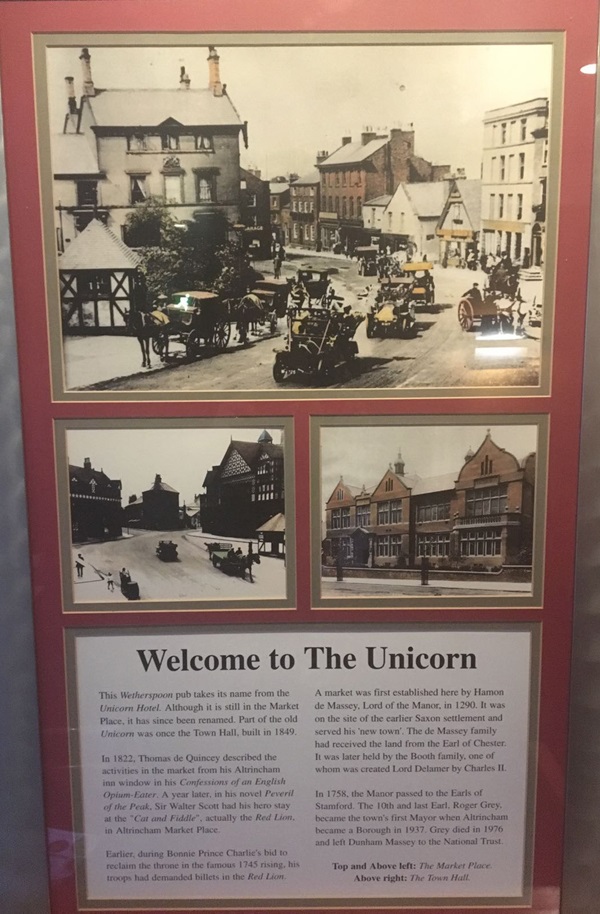
The text reads: This Wetherspoon pub takes its name from the Unicorn Hotel. Although it is still in the Market Place, it has since been renamed. Part of the old Unicorn was once the Town Hall, built in 1849.
In 1822, Thomas de Quincey described the activities in the market from his Altrincham inn window in his Confessions of an English Opium-Eater. A year later, in his novel Peveril of the Peak, Sir Walter Scott had his hero stay at the “Cat and Fiddle”, actually the Red Lion, in Altrincham Market Place.
Earlier, during Bonnie Prince Charlie’s bid to reclaim the throne in the famous 1745 rising, his troops had demanded billets in the Red Lion.
A market was first established here by Hamon de Massey, Lord of the Manor, in 1290. It was on the site of the earlier Saxon settlement and served his new town. The de Massey family had received the land from the Earl of Chester. It was later held by the Booth family, one of whom was created Lord Delamer by Charles II.
In 1758, the Manor passed to the Earls of Stamford. The 10th and last Earl, Roger Grey, became the town’s first mayor when Altrincham became a Borough in 1937. Grey died in 1976 and left Dunham Massey to the National Trust.
Top and above left: The Market Place
Above right: The Town Hall.
Prints, illustrations and text about transport and commuting in the area.
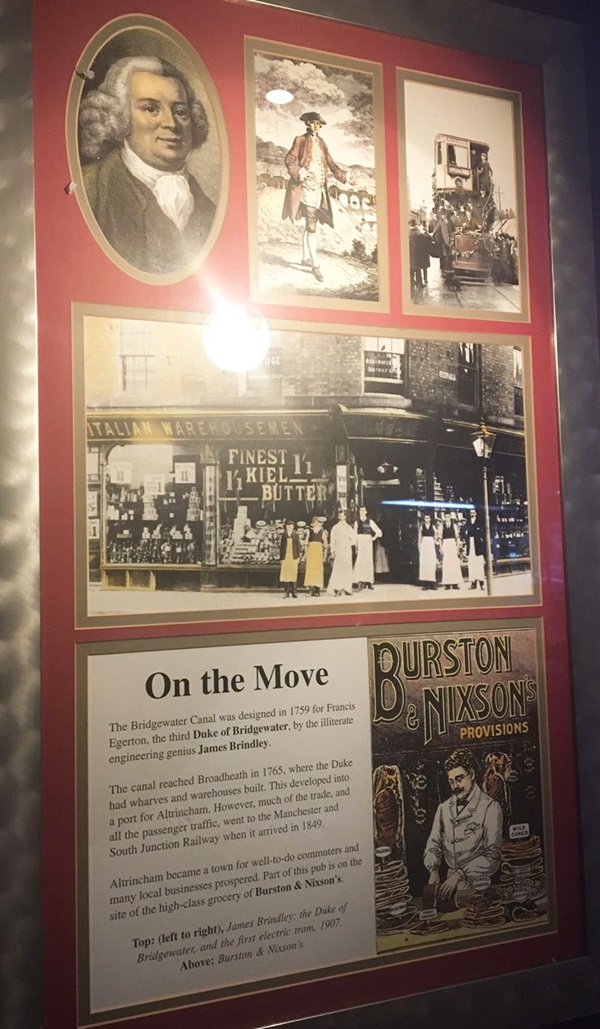
The text reads: The Bridgewater Canal was designed in 1759 for Francis Egerton, the third Duke of Bridgewater, by the illiterate engineering genius James Brindley.
The canal reached Broadheath in 1765, where the Duke had wharves and warehouses built. This developed into a port of Altrincham. However, much of the trade, and all the passenger traffic, went to the Manchester and South Junction Railway when it arrived.
Altrincham became a town for well-to-do commuters and many local businesses prospered. Part of this pub is on the site of the high class grocery of Burston & Nixon’s.
Top: (left to right), James Brindley; the Duke of Bridgewater, and the first electric tram, 1907
Above: Burston & Nixon’s.
Prints and text about entertainment in Altrincham.
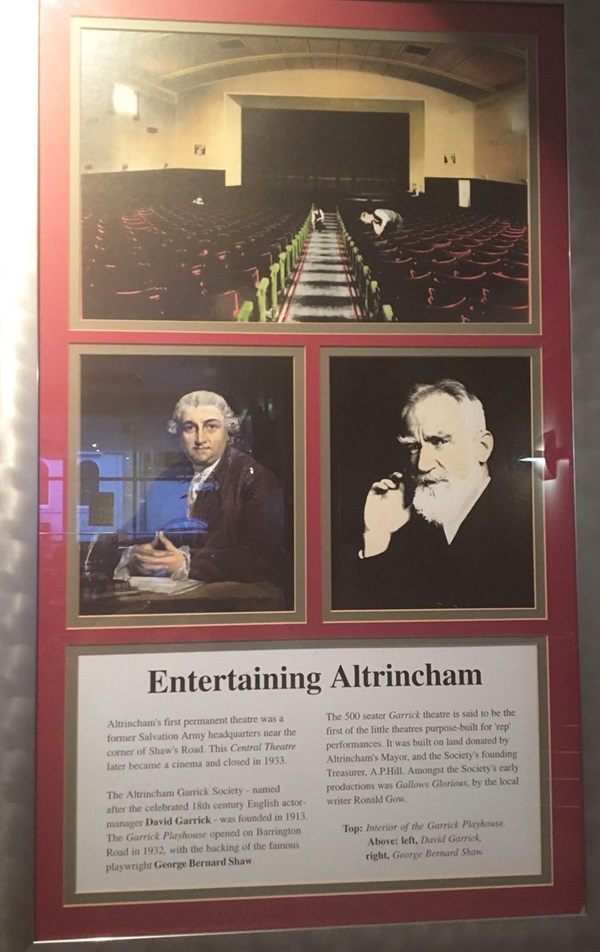
The text reads: Altrincham’s first permanent theatre was a former Salvation Army headquarters near the corner of Shaw’s Road. This Central Theatre later became a cinema and closed in 1933.
The Altrincham Garrick Society – named after the celebrated 18th century English actor, manager David Garrick – was founded in 1913. The Garrick Playhouse opened on Barrington Road in 1932, with the backing of the famous playwright George Bernard Shaw.
The 500 seater Garrick theatre is said to be the first of the little theatres purpose built for ‘rep’ performances. It was built on land donated by Altrincham’s mayor, and the society’s founding treasurer, AP Hill. Amongst the society’s early productions was Gallows Glorious, by the local writer Ronald Gow.
Top: Interior of the Garrick Playhouse
Above: left, David Garrick, right, George Bernard Shaw.
Prints and text about literary links.
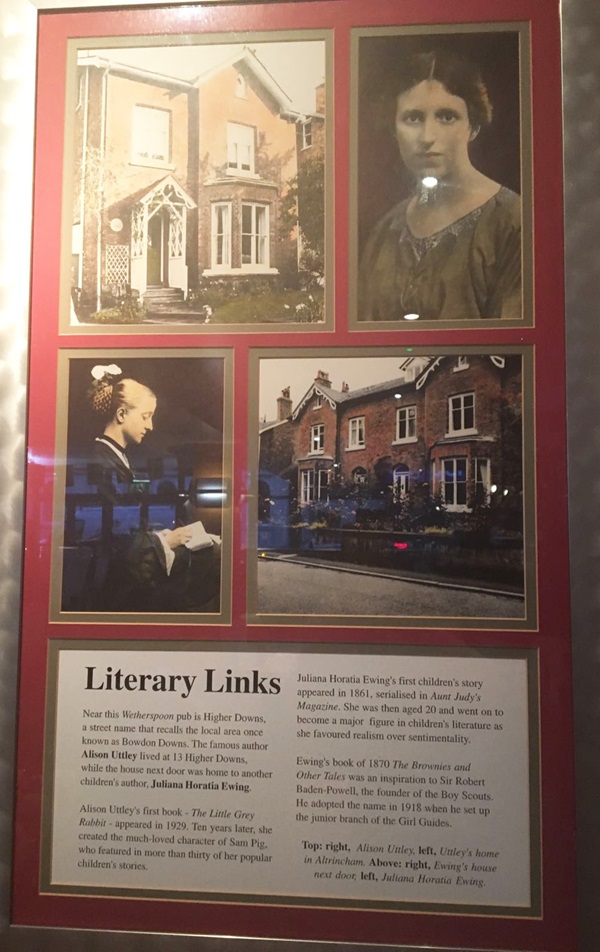
The text reads: Near this Wetherspoon pub is Higher Downs, a street name that recalls the local area once known as Bowdon Downs. The famous author Alison Uttley lived at 13 Higher Downs, while the house next door was home to another children’s author, Juliana Horatia Ewing.
Alison Uttley’s first book – The Little Grey Rabbit – appeared in 1929. Then years later, she created the much loved character of Sam Pig, who featured in more than thirty of her popular children’s stories.
Juliana Horatia Ewing’s first children’s story appeared in 1861, serialised in Aunt Judy’s Magazine. She was then aged 20 and went on to become a major figure in children’s literature as she favoured realism over sentimentality.
Ewing’s book of 1870 The Brownies and Other Tales was an inspiration to Sir Robert Baden-Powell, the founded of the Boy Scouts. He adopted the name in 1918 when he set up the junior branch of the Girl Guides.
Top: right, Alison Uttley, left, Uttley’s home in Altrincham
Above: right, Ewing’s house next door, left, Juliana Horatia Ewing.
Prints and text about Broadheath.
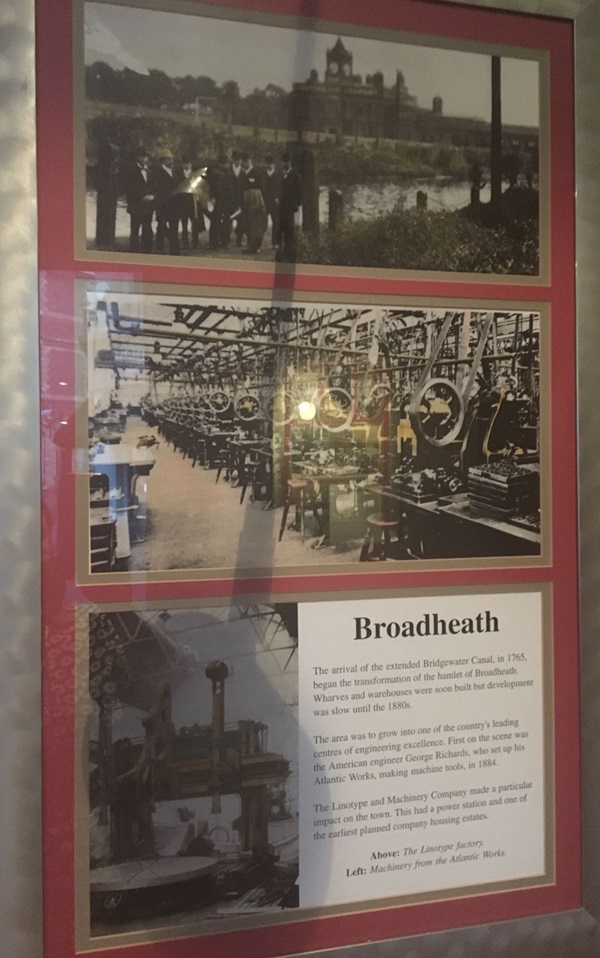
The text reads: The arrival of the extended Bridgewater Canal, in 1765, began the transformation of the hamlet of Broadheath. Wharves and warehouses were soon built but development was slow until the 1880s.
The area was to grow into one of the country’s leading centres of engineering excellence. First on the scene was the American engineer George Richards, who set up his Atlantic Works, making machine tools, in 1884.
The Linotype and Machinery Company made a particular impact of the town. This had a power station and one of the earliest planned company housing estates.
Above: The Linotype factory
Left: Machinery from the Atlantic Works.
Prints of the earls of Stamford.
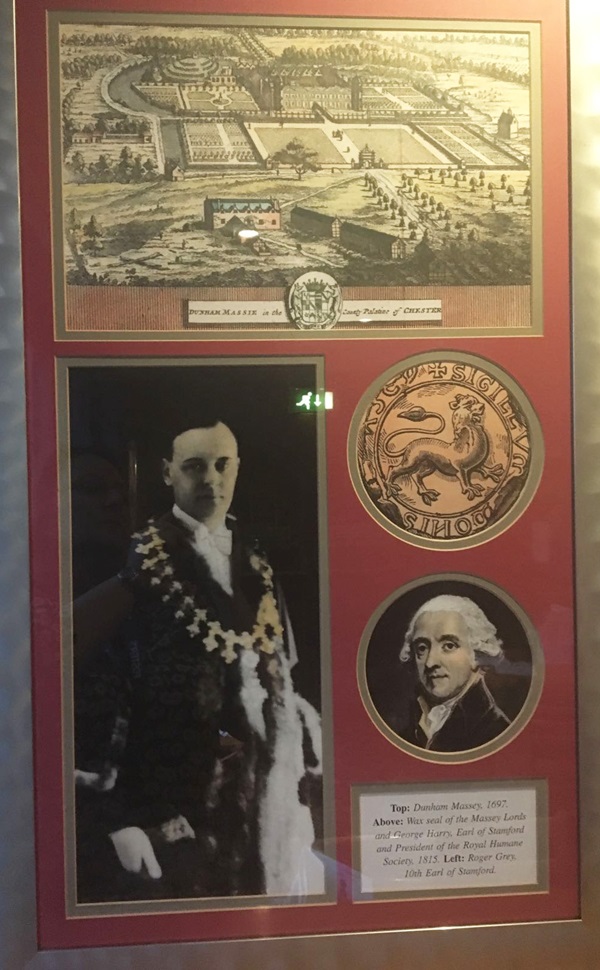
Top: Dunham Massey, 1697
Above: Wax seal of the Massey Lords and George Harry, Earl of Stamford and President of the Royal Humane Society, 1815
Left: Royal Grey, 10th Earl of Stamford.
If you have information on the history of this pub, then we’d like you to share it with us. Please e-mail all information to: pubhistories@jdwetherspoon.co.uk